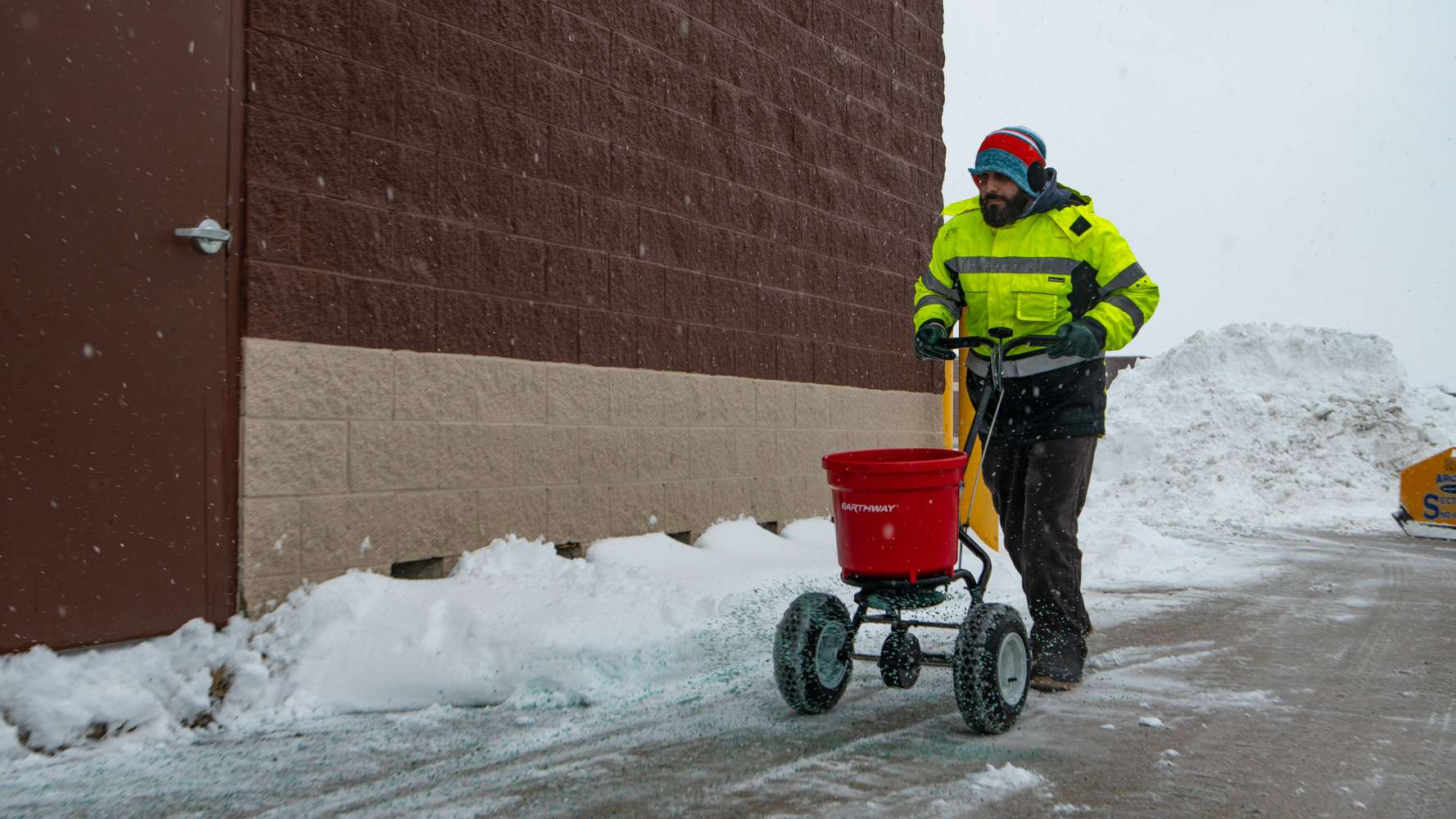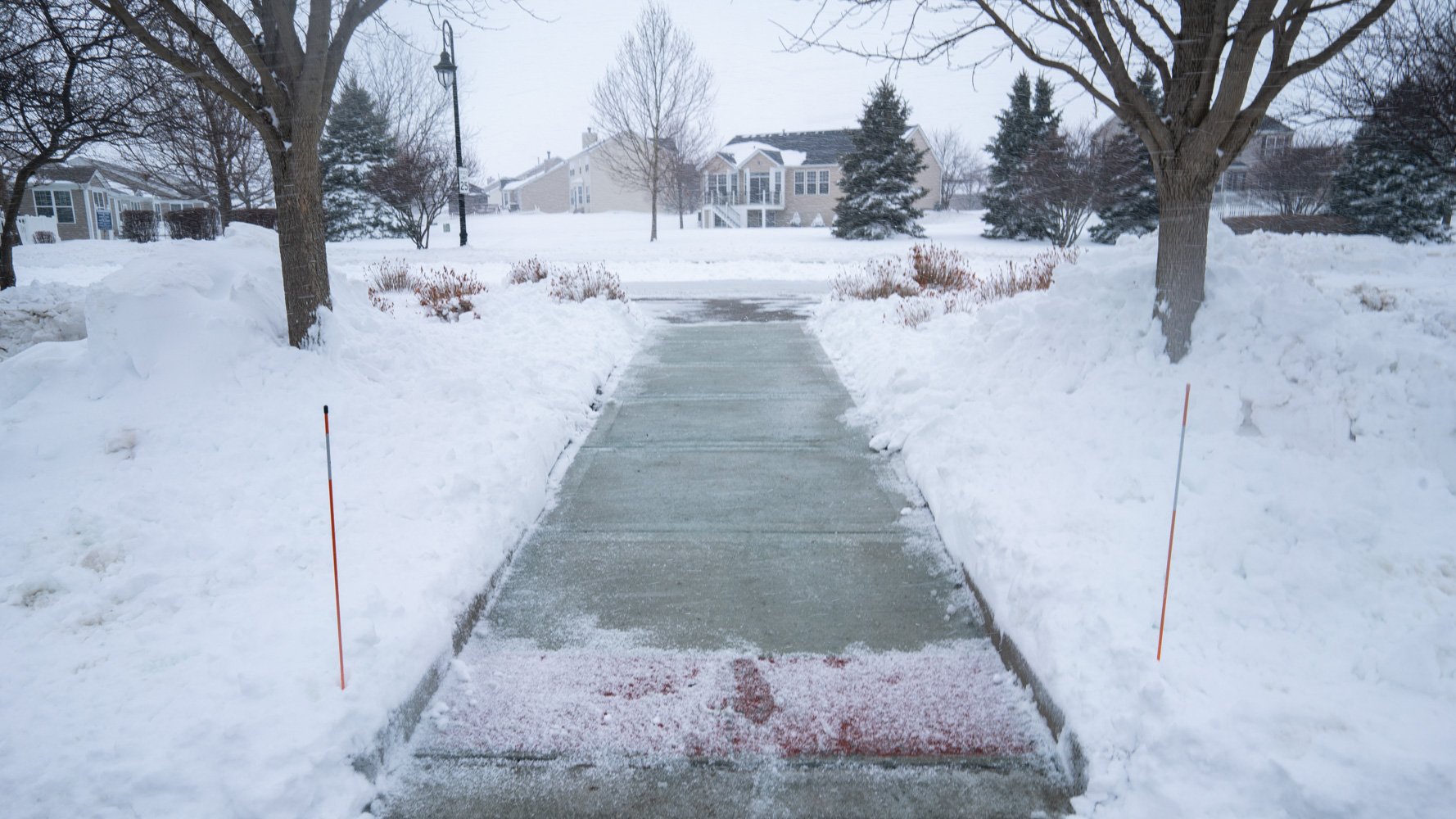The winter schedule in Greater Chicago amounts to the snow piling up and then melting again, and then piling up and then melting again. And then the temperatures drop.
What comes next? You guessed it, ice.
As your commercial property’s sidewalks, pathways, entryways, and parking lots quickly glaze over, they become instantly slick. For a Greater Chicago commercial property, slick means slips and falls, possible accidents and maybe even property damage or liability concerns. Not cool.
Enter ice melt products: ice-melting saviors. These products can keep that ice from building by lowering the freezing point of water. But which one is better – rock salt vs. calcium chloride? Here are the differences so you can understand which one makes more sense to use at your commercial property.
Rock Salt vs. Calcium Chloride
Let’s start by talking about the difference between rock salt vs. calcium chloride.
Rock salt, or sodium chloride, is actually fairly self-explanatory. Yes, it’s the same salt you use at the dinner table, but for snow-melting purposes it comes in larger chunks.

Calcium chloride, on the other hand, can be derived from limestone and is considered an inorganic compound that classifies as a type of salt. It usually looks a little different than rock salt; it’ll come in more of a pellet form that resembles sand grains or flakes.
While both products have the ultimate goal of melting ice, they each have their pros and cons.
Rock Salt: Pros & Cons
Rock salt is sodium chloride or table salt.
Rock salt is gritty so it creates an instantly grippable surface as it does its job. What it does is penetrate ice to form a water and salt combination, also known as brine. Brine’s freezing point is lower than water alone, so as long as adequate salt is present, water on your commercial pavement shouldn’t freeze over. It is effective at melting ice as low as 15 degrees Fahrenheit.
Rock salt is also easily available except when extreme and extended winter weather has caused local shortages. It’s also the most inexpensive ice-melting option and is considered a pet safe ice melt that is easy to use.
However, while using rock salt as types of ice melt, you should also consider its cons.
Rock salt can be harmful to some plant life if used improperly, so using it too close to prime landscape beds is not a good idea. But using it on large, open areas like parking lots is effective and no threat to vegetation.
Calcium Chloride: Pros & Cons
Types of ice melt like calcium chloride are inorganic compounds combining calcium and chlorine.
It can melt ice faster than other ice melts, forming brine quickly, lowering the freezing point of water. It also generates heat as it dissolves. This can be helpful in areas where you need fast deicing like entryways of hospitals.

This product can be less harmful to plants than other deicers, but you still want to use it properly.
On the con list, calcium chloride is not a pet safe ice melt. It can also be messy, leaving a white residue on surfaces.
Ice melt products are made from a combination of various chlorides, including magnesium, potassium, calcium, and sodium.
Ice melt is less harmful to pets and plants, so it can be used closer to areas where you don’t want to risk plant burning or damage from salt. It can also be more expensive than rock salt.
Rock Salt vs. Calcium Chloride? Which Should I Choose?
Deciding between rock salt vs. calcium chloride is a frequent dilemma when trying to clear snow and ice safely in Greater Chicago.
Here, we’ve compared their differing properties to help you select the optimal ice-melt solution for your commercial landscape needs.
The cheaper and more accessible option is rock salt. This is an abundant substance, meaning shipping costs are typically lower. For most companies, rock salt is a good solution because it's affordable, accessible, and effectively lowers the freezing point of water.
When it comes to ease of application, rock salt is also generally the more convenient option for ice melting. It’s easy to spread by hand or with a spreader, and can be applied without special equipment. Calcium chloride may require some more effort to obtain and apply properly even though it does come in an easy-to-spread form. It isn’t as widely available, requiring purchase from specific suppliers.
Calcium chloride has an edge when it comes to ice melting though since it can melt ice at temperatures as low as negative 20 degrees Fahrenheit. So calcium chloride can be important to use during colder winters or colder periods of winter, while rock salt can be better for milder winters.
Calcium chloride can also be better for plant health, being less likely to burn when properly applied around your lawn, shrubs, and trees. When rock salt is absorbed by plant roots, this can lead to scorched leaves if hydration isn’t adequate to balance this out or if the product wasn’t applied correctly.
What’s Your Ideal Ice Management Solution?
While rock salt vs calcium chloride both have their pros and cons, each one can be incredibly effective in commercial snow removal services in Greater Chicago.
In fact, there isn’t a definitive answer on which one is best to use overall. However, the approach you prefer could be a combination of the two based on weather patterns, as well as your commercial property’s specific needs.

A truly effective ice management strategy will require you to consider some aspects of your commercial facility. Do you manage a facility that requires total removal of ice and snow in some areas at all hours? A hospital or health care facility may fall into this category. In this case, a combination of calcium chloride on walkways and entryways and rock salt on parking lots and open areas could be your best bet to ensure safety and reduce liability, while remaining within a budget.
If you operate an industrial facility with large, open parking areas and few plant beds that could be at risk from too much salt, rock salt may be the only thing you need in your ice-fighting arsenal.
Trust Your Slick Surfaces to KD Landscape for Commercial Landscaping in Chicago
Ice build-up on your commercial landscaping in Chicago can be pretty scary. Not only don’t you want complaints from employees or visitors who are slipping and having a hard time accessing your site, but you also don’t want to increase the risk of trips, falls, and accidents at your property.

And Old Man Winter, in the meantime, is relentless in his ability to just drop a winter storm at the worst possible moment, like when you have a big sale happening at your retail facility or during rush hour at your office park. He’s so inconsiderate.
You just want the ice melted and not to have to worry about it. What property manager needs more headaches? We completely understand.
When it comes to grasping the differences between rock salt vs calcium chloride, we can help you figure out what’s best for your property based on your specific needs and goals. Rock salt may be all you need, but calcium chloride could have some advantages in specific areas if you require a faster or more plant-safe solution.
Instead of trying to figure out the balance of which products to use and how they impact your costs on your own, let KD Landscape help you by providing a plan to fit your budget and meet all of your needs, making you look pretty smart in the process.
KD Landscape would be happy to discuss some specific ideas that could improve safety and security at your commercial facility and fit within your budget so you are the property champion. Request a proposal today. We’ll review your options together so you can make the best choice.





